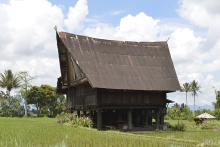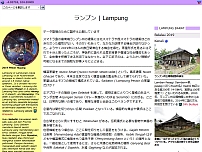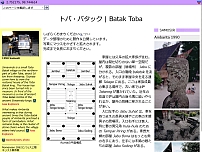ベセマー / パセマー | Besemah / Pasemah
データ整理のために製作&公開しています。
南スマトラの Dempo山(標高3173mの活火山)の山麓にひろがる高原地帯は、現在のパガララム Pagaralam、ラハト Lahat を中心に多くの巨石遺構が散在し、古代に文化的中心があったことをうかがわせる。19世紀にオランダがこの地の統治に乗り出して以来、Pasemah の名は海外にも知られるようになるが、本来の現地の呼称は Besemah である。
伝統家屋を Ghumah Baghi(Ghumah=家、Baghi=古い)という。北スマトラのトバ・バタックとよく似た大屋根構造の家屋本体を太い自立柱(束)で持ち上げた高床建築であり、彫刻の有無によって3つの建築類型を区別している。
Ghumah Baghi Tatahan 彫刻のある家
Ghumah Baghi Ghilipan 彫刻のない家
Ghumah Baghi Sasak 網代壁の家
彫刻は家屋の格を決めるほど重要な要素で、建設費の三分の一は彫刻のために費やされるという。ひとつの部材を彫るだけで3ヶ月を要し、完成するたびにニワトリを一羽供犠する必要があったのである。壁面や扉を飾るヒマワリ、ハス、バラなどの花柄模様やタケノコなどのモチーフには家屋によって異なる意味と象徴性がこめられている。
また間仕切りのない屋内空間には、社会階層に応じた段差がもうけられている。とくに4年に一度、家宝をあらためる儀式をおこなう際には、長老 jurei tue がもっとも高い部分に座をしめる。。。
PAGAR ALAM

Suka Merindu, Lahat 2013
Rambaikaca 

彫刻のない家
Ghumah Baghi Ghilapan




彫刻のある家
Ghumah Baghi Tatahan


bubulan 八方位をもつ一種のマンダラ。中心に覗き穴がある



四隅の壁柱には子孫繁栄を象徴する筍のモチーフ






夫婦の寝室 Bilek

床下にある炊事場 Paun への入口


Dempo Utara 2013/2019
Tegur Wangi 
Pasemah高原を紹介するメディアではお馴染みの建物。絵のような景観は印象的だが、Pasemah 本来の建築構造ではない




 伝統家屋の太い柱が入手困難なためか、敷き土台を利用したあたらしい構法
伝統家屋の太い柱が入手困難なためか、敷き土台を利用したあたらしい構法
Pagaralam Selatan 2013
Belumai 


Dempo Tangah 2013
Karang Dalo 








LAHAT
Pagar Gunung 2019
Tanjung Agung 





Mulak Sebingkai 2019
Jadian Baru 



Merapi Selatan 2019
Geramat 
彫刻のある家Ghumah Baghi Tatahan







炊事屋


彫刻のない家
Ghumah Baghi Ghilapan






炊事屋
網代壁の家
Ghumah Baghi Sasak



別棟の炊事屋がない

太い自立柱の構造をあきらめ敷き土台を利用




Mulak Ulu 2019
Pajar Bulan 










2013 Lahat
Ogan-Besemah: Residents of the area sometimes refer to the entire grouping as Ogan" or "Dempo" people, but more often distinguish between two subfamilies: the Besemah subgroup to the west (often written "Pasemah") and the Ogan subgroup to the east...Dutch rule began in 1816, but was largely limited to the area around Palembang city. Local rulers carried out active resistance to Dutch conquest, and only in 1866 was the entire area officially under colonial control.  Encyclopedia of World Cultures
Encyclopedia of World Cultures
Pasemah was the name given by a foreigner to this people group due to a difference in pronunciation. Their name is actually Besemah, which is more consistent with how they themselves and other people groups around them would pronounce the name. The center of the Besemah territory is the volcanic peak, Mount Dempo. Besemah communities spread from that volcano's slopes to the west, south and southwest along the Bukit Barisan mountain range.  Joshuaproject
Joshuaproject
The Besemah people inhabit the southern highlands of Sumatra. Unlike many neighbouring peoples, the Besemah maintained their indigenous religion, which was based largely their founding ancestors (known as poyang) until the late nineteenth century. The nearby volcano Gunung Dempo was sacred to the Besemah people, and was believed to be inhabited by various supernatural agents, including the spirits of their dead.
 Pulotu
Pulotu
The Pasemah people are believed to have originated in Borneo before migrating to Sumatra and the Pasemah Plateau. The Pasemah of Sumatra people cluster encompasses the Pasemah and several related ethnic groups that speak Central Malay and practice Sunni Islam.
Peoples within this cluster: Kaur; Kikim; Lematang; Lintang; Pasemah; Semendo; Serawai / Population: 1,375,000  Peoplegroups
Peoplegroups
Ghumah Baghi atau Rumah Baghi, atau Ghumah Tatahan, merupakan rumah adat tradisional di Provinsi Sumatra Selatan yang dibangun oleh Suku Besemah (atau disebut juga Pasemah). Secara etimologis dalam Bahasa Indonesia Ghumah artinya Rumah, sedangkan Baghi (dibaca: bari) artinya tua. Selain diartikan sebagai rumah lama, tua atau kuno, bisa juga Ghumah Baghi disebut sebagai "rumah peninggalan zaman dahulu kala".
 id.Wikipedia
id.Wikipedia
Palsafah "Bubulan" pada Rumah Baghi Besemah  KasKus
KasKus
OGAN
The Ogan people are an ethnolinguistic group of South Sumatra, found along the Ogan river valley. The Ogan of Sumatra people cluster encompasses the Ogan and a handful of related ethnic groups whose languages were once thought to be distinct but are now classified as dialects of Central Malay or Musi.
Peoples within this cluster: Belide; Enim; Ogan; Pegagan; Penesak / Population: 662,000  Peoplegroups
Peoplegroups
Rumah ulu is a vernacular house found in the highland of South Sumatra, Indonesia. The house is associated with the Uluan people who reside in the region of the upstream of the Ogan and Musi River....No new ulu house have been constructed since the 1920s. A 200 years old ulu house is kept in the Balaputradeva Museum. The rumah ulu in the museum was taken from Asamkelat Village in Pengandonan Subdistrict of Ogan Komering Ulu Regency.  Wikipedia
Wikipedia
 id.Wikipedia
id.Wikipedia


Balaputradeva Museum 南スマトラ州立博物館に野外展示された Ulu House
巨石文化
写真説明は現地解説板の記述PAGARALAM AREA
Gunung Megang





Kubur Batu
 周囲の景観
周囲の景観
 Arca Manusia “Batu Putri”
Arca Manusia “Batu Putri” Arca Manusia
Arca ManusiaTanjung Aro

周囲の景観

Arca Manusia Dililit Ural:罰として蛇にまかれて死んだ未婚の男女の伝承がある



Kubur Batu
この石室墓は1931年にオランダの考古学者 Van Der Hoop が発掘した
Belumai

Batu Berrelief / Batu Gajah


Kubur Batu


Arca Manusia dan Batu Datar
Tegur Wangi

周囲の景観



Kubur Batu


Arca Manusia


Dolmen
LAHAT AREA
Komplek Magalith Tanjung Raja






Komplek Magalith Tinggihari 1



Menhir:子どもを担ぎ、奴隷らしき者を踏んだ人物像。さらにワニらしき動物がいる


Arca Manusia:胡座を組んだ座像。首飾りをした頭部はすでにない




Arca Babi:1984年に発見された豚の像。首の部分にはすでに頭の欠けた人物像がある。未完成作品らしい
Komplek Magalith Tinggihari 2



Arca Manusia:子どもを抱いて座る女性像
Komplek Magalith Tinggihari 3


Arca Manusia:ヘルメット風の帽子を被っていたがすでに折れてない。頭を突き出し、丸い目、低い鼻、大きな耳をした人物像。手と足に輪飾りをつけている




Arca Manusia:楕円形の目、低い鼻、幅広の口、突き出た頭飾りをした人物。Imam像として知られる
entenam : メルサワ。フタバガキ科の広葉樹。柱、床壁などに利用。彫刻に最適。祖先puyangから最上等の木と考えられている。mersawa [Anisoptera sp.]
 木材博物館
木材博物館
gelemar : 屋根
ghimau : surian [Toona sureni Merr.]
cemaghe : ラサマラ。マンサク科 壁、戸枠 彫刻によく、耐久性あり。 Rasamala [Altingia excelsa]
medang derian : 戸枠
merambung (sirap) 屋根のsirapは熱暑と雨に耐える
- Taal, Sandra 'The limas house of Palembang', in R. Schefold & P. Nas & G. Domenig & R. Wessing (eds.) "INDONESIAN HOUSES, VOL. 2: SURVEY OF VERNACULAR ARCHITECTURE IN WESTERN INDONESIA", Verhandelingen van het Koninklijk Instituut voor Taal-, Land- en Volkenkunde 251, pp.363-389, KITLV Press, Leiden, 2008
- Barendregt, Bart 'The house that was built overnight’: Guidelines on the construction and use of the southern Sumatran rumah uluan', in R. Schefold & P. Nas & G. Domenig & R. Wessing (eds.) "INDONESIAN HOUSES, VOL. 2: SURVEY OF VERNACULAR ARCHITECTURE IN WESTERN INDONESIA", Verhandelingen van het Koninklijk Instituut voor Taal-, Land- en Volkenkunde 251, pp.429-464, KITLV Press, Leiden, 2008
- Putra, Irawansah "Pola Ragam Hias Ghumah Baghi Di Desa Gunung Agung Pauh Kecamatan Dempo Utara Kota Pagaralam", Universitas Islam Negeri Raden Fatah Palembang, 2016
 UIN Raden Fatah
UIN Raden Fatah - Nugroho, Setyo & Husnul, Hidayat "Tipologi Arsitektur Rumah Ulu di Sumatera Selatan", Prosiding Seminar Nasional temu Ilmiah IPLBI 2016. pp. 145-150, 2016
- Hidayat, Husnul "Arsitektur Rumah Ulu Ogan", NALARs 17-2, pp.129-134, 2018
- Oktarini, Maya Fitri "The Spreading of Vernacular Architecture at the Riverways of South Sumatra, Indonesia", Indonesian Journal of Geography 51-2, pp.199-206, 2019
 Researchgate
Researchgate - Harum, Oktarine Melly Aminah etc. "Pelestarian Ghumah Baghi (rumah Tradisional Berbahan Dasar Kayu) Di Kelurahan Pelang Kenidai, Kota Pagaralam", Jurnal Hutan Tropis 7-2, pp.216-224, 2019




 ランプン | Lampung
ランプン | Lampung


 本ページ中に間違いを発見された方はどうかご連絡ください。誤った情報は改めていきます
本ページ中に間違いを発見された方はどうかご連絡ください。誤った情報は改めていきます